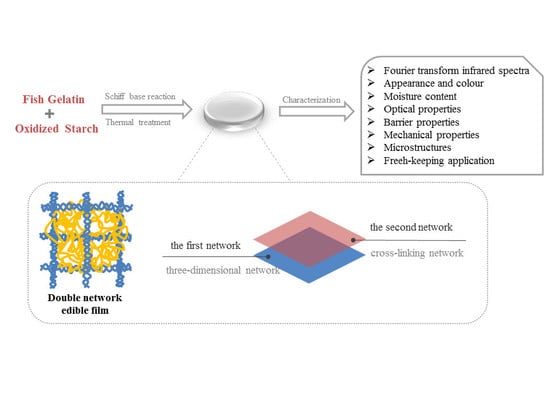Development and Properties of Fish Gelatin/Oxidized Starch Double Network Film Catalyzed by Thermal Treatment and Schiff’ Base Reaction
Abstract
:1. Introduction
2. Materials and Methods
2.1. Materials and Reagents
2.2. Preparation of Fish Gelatin/Oxidized Starch Composite Film
2.3. Fourier Transform Infrared (FT-IR) Spectroscopy
2.4. Physico-Chemical Properties of Films
2.4.1. Color Values
2.4.2. Film Thickness
2.4.3. Moisture Content (MC)
2.4.4. Water Vapor Permeability (WVP)
2.4.5. Permeability to Oil
2.4.6. Film Permeability to Oxygen
2.4.7. Light Transmission and Transparency of Films
2.4.8. Mechanical Properties of Films
2.4.9. Microstructure of Films
2.5. Fresh-Keeping Properties of Films
2.5.1. Color of the Blueberry Samples
2.5.2. Weight Loss (WL) of the Blueberry Samples
2.5.3. Total Soluble Solids (TSS) Content and pH of the Blueberry Samples
2.5.4. Titratable Acidity (TA) Content of the Blueberry Samples
2.5.5. Total Anthocyanin Content of the Blueberry Samples
2.6. Statistical Analysis
3. Results and Discussion
3.1. Intermolecular Interaction between FG and OS
3.2. Physico-Chemical Properties
3.2.1. Color Values of Films
3.2.2. Optical Properties of Films
3.2.3. Moisture Contents of Films
3.2.4. Barrier Properties of Films
3.2.5. Mechanical Properties of Films
3.2.6. Appearance and Morphology of Films
3.3. Freeh-Keeping Properties of Films
3.3.1. Color Values of Blueberries
3.3.2. Weight Loss of Blueberries
3.3.3. Total Soluble Solids Contents and pH
3.3.4. Titratable Acidity and Total Anthocyanin Content
4. Conclusions
Supplementary Materials
Author Contributions
Funding
Acknowledgments
Conflicts of Interest
References
- Barikloo, H.; Ahmadi, E. Effect of nanocomposite-based packaging and chitosan coating on the physical, chemical, and mechanical traits of strawberry during storage. J. Food Meas. Charact. 2018, 12, 1795–1817. [Google Scholar] [CrossRef]
- Cao, L.; Liu, W.; Wang, L. Developing a green and edible film from Cassia gum: The effects of glycerol and sorbitol. J. Clean. Prod. 2018, 175, 276–282. [Google Scholar] [CrossRef]
- Carpiné, D.; Dagostin, J.L.A.; Bertan, L.C.; Mafra, M.R. Development and Characterization of Soy Protein Isolate Emulsion-Based Edible Films with Added Coconut Oil for Olive Oil Packaging: Barrier, Mechanical, and Thermal Properties. Food Bioprocess Technol. 2015, 8, 1811–1823. [Google Scholar] [CrossRef]
- Chen, H.; Ji, A.; Qiu, S.; Liu, Y.; Zhu, Q.; Yin, L. Covalent conjugation of bovine serum album and sugar beet pectin through Maillard reaction/laccase catalysis to improve the emulsifying properties. Food Hydrocoll. 2018, 76, 173–183. [Google Scholar] [CrossRef]
- Chen, H.; Qiu, S.; Gan, J.; Liu, Y.; Zhu, Q.; Yin, L. New insights into the functionality of protein to the emulsifying properties of sugar beet pectin. Food Hydrocoll. 2016, 57, 262–270. [Google Scholar] [CrossRef]
- Chen, H.; Shan, Z.H.; Woo, M.W.; Chen, X.D. Preparation and characteristic of gelatine/oxidized corn starch and gelatin/corn starch blend microspheres. Int. J. Biol. Macromol. 2017, 94 Pt A, 326–334. [Google Scholar] [CrossRef]
- Figueroa-Lopez, K.J.; Andrade-Mahecha, M.M.; Torres-Vargas, O.L. Development of Antimicrobial Biocomposite Films to Preserve the Quality of Bread. Molecules 2018, 23, 212. [Google Scholar] [CrossRef] [Green Version]
- Galus, S. Functional properties of soy protein isolate edible films as affected by rapeseed oil concentration. Food Hydrocoll. 2018, 85, 233–241. [Google Scholar] [CrossRef]
- Giuggioli, N.R.; Girgenti, V.; Peano, C. Qualitative Performance and Consumer Acceptability of Starch Films for the Blueberry Modified Atmosphere Packaging Storage. Pol. J. Food Nutr. Sci. 2017, 67, 129–136. [Google Scholar] [CrossRef]
- González, A.; Barrera, G.N.; Galimberti, P.I.; Ribotta, P.D.; Alvarez Igarzabal, C.I. Development of edible films prepared by soy protein and the galactomannan fraction extracted from Gleditsia triacanthos (Fabaceae) seed. Food Hydrocoll. 2019, 97, 105227. [Google Scholar] [CrossRef]
- Gutiérrez, T.J.; Alvarez, V.A. Properties of native and oxidized corn starch/polystyrene blends under conditions of reactive extrusion using zinc octanoate as a catalyst. React. Funct. Polym. 2017, 112, 33–44. [Google Scholar] [CrossRef]
- Hajji, S.; Younes, I.; Affes, S.; Boufi, S.; Nasri, M. Optimization of the formulation of chitosan edible coatings supplemented with carotenoproteins and their use for extending strawberries postharvest life. Food Hydrocoll. 2018, 83, 375–392. [Google Scholar] [CrossRef]
- Han, Y.; Yu, M.; Wang, L. Preparation and characterization of antioxidant soy protein isolate films incorporating licorice residue extract. Food Hydrocoll. 2018, 75, 13–21. [Google Scholar] [CrossRef]
- Hazaveh, P.; Mohammadi Nafchi, A.; Abbaspour, H. The effects of sugars on moisture sorption isotherm and functional properties of cold water fish gelatin films. Int. J. Biol. Macromol. 2015, 79, 370–376. [Google Scholar] [CrossRef] [PubMed]
- Jamróz, E.; Kopel, P.; Juszczak, L.; Kawecka, A.; Bytesnikova, Z.; Milosavljević, V.; Kucharek, M.; Makarewicz, M.; Adam, V. Development and characterisation of furcellaran-gelatin films containing SeNPs and AgNPs that have antimicrobial activity. Food Hydrocoll. 2018, 83, 9–16. [Google Scholar]
- Kchaou, H.; Benbettaïeb, N.; Jridi, M.; Abdelhedi, O.; Karbowiak, T.; Brachais, C.-H.; Léonard, M.-L.; Debeaufort, F.; Nasri, M. Enhancement of structural, functional and antioxidant properties of fish gelatin films using Maillard reactions. Food Hydrocoll. 2018, 83, 326–339. [Google Scholar] [CrossRef]
- Kowalczyk, D.; Biendl, M. Physicochemical and antioxidant properties of biopolymer/candelilla wax emulsion films containing hop extract—A comparative study. Food Hydrocoll. 2016, 60, 384–392. [Google Scholar] [CrossRef]
- Kowalczyk, D.; Kordowska-Wiater, M.; Nowak, J.; Baraniak, B. Characterization of films based on chitosan lactate and its blends with oxidized starch and gelatin. Int. J. Biol. Macromol. 2015, 77, 350–359. [Google Scholar] [CrossRef]
- Li, C.; Zhu, W.; Xue, H.; Chen, Z.; Chen, Y.; Wang, X. Physical and structural properties of peanut protein isolate-gum Arabic films prepared by various glycation time. Food Hydrocoll. 2015, 43, 322–328. [Google Scholar] [CrossRef]
- Li, K.; Jin, S.; Liu, X.; Chen, H.; He, J.; Li, J. Preparation and Characterization of Chitosan/Soy Protein Isolate Nanocomposite Film Reinforced by Cu Nanoclusters. Polymers 2017, 9, 247. [Google Scholar] [CrossRef] [Green Version]
- Li, W.; Zheng, K.; Chen, H.; Feng, S.; Wang, W.; Qin, C. Influence of Nano Titanium Dioxide and Clove Oil on Chitosan-Starch Film Characteristics. Polymers 2019, 11, 1418. [Google Scholar] [CrossRef] [PubMed] [Green Version]
- Liu, Z.; Ge, X.; Lu, Y.; Dong, S.; Zhao, Y.; Zeng, M. Effects of chitosan molecular weight and degree of deacetylation on the properties of gelatine-based films. Food Hydrocoll. 2012, 26, 311–317. [Google Scholar] [CrossRef]
- López de Dicastillo, C.; Bustos, F.; Guarda, A.; Galotto, M.J. Cross-linked methyl cellulose films with murta fruit extract for antioxidant and antimicrobial active food packaging. Food Hydrocoll. 2016, 60, 335–344. [Google Scholar] [CrossRef]
- Mahajan, B.V.; Dhillon, W.S.; Kumar, M.; Singh, B. Effect of different packaging films on shelf life and quality of peach under super and ordinary market conditions. J. Food Sci. Technol. 2015, 52, 3756–3762. [Google Scholar] [CrossRef] [PubMed] [Green Version]
- Mannozzi, C.; Cecchini, J.P.; Tylewicz, U.; Siroli, L.; Patrignani, F.; Lanciotti, R.; Rocculi, P.; Dalla Rosa, M.; Romani, S. Study on the efficacy of edible coatings on quality of blueberry fruits during shelf-life. LWT-Food Sci. Technol. 2017, 85, 440–444. [Google Scholar] [CrossRef]
- Moggia, C.; Beaudry, R.M.; Retamales, J.B.; Lobos, G.A. Variation in the impact of stem scar and cuticle on water loss in highbush blueberry fruit argue for the use of water permeance as a selection criterion in breeding. Postharvest Biol. Technol. 2017, 132, 88–96. [Google Scholar] [CrossRef] [Green Version]
- Parra, J.; Ripoll, G.; Orihuel-Iranzo, B. Potassium sorbate effects on citrus weight loss and decay control. Postharvest Biol. Technol. 2014, 96, 7–13. [Google Scholar] [CrossRef]
- Priyadarshi, R.; Sauraj; Kumar, B.; Deeba, F.; Kulshreshtha, A.; Negi, Y.S. Chitosan films incorporated with Apricot (Prunus armeniaca) kernel essential oil as active food packaging material. Food Hydrocoll. 2018, 85, 158–166. [Google Scholar] [CrossRef]
- Sangseethong, K.; Termvejsayanon, N.; Sriroth, K. Characterization of physicochemical properties of hypochlorite- and peroxide-oxidized cassava starches. Carbohydr. Polym. 2010, 82, 446–453. [Google Scholar] [CrossRef]
- Sapper, M.; Wilcaso, P.; Santamarina, M.P.; Roselló, J.; Chiralt, A. Antifungal and functional properties of starch-gellan films containing thyme (Thymus zygis) essential oil. Food Control 2018, 92, 505–515. [Google Scholar] [CrossRef]
- Saricaoglu, F.T.; Tural, S.; Gul, O.; Turhan, S. High pressure homogenization of mechanically deboned chicken meat protein suspensions to improve mechanical and barrier properties of edible films. Food Hydrocoll. 2018, 84, 135–145. [Google Scholar] [CrossRef]
- Silva-Weiss, A.; Bifani, V.; Ihl, M.; Sobral, P.J.A.; Gómez-Guillén, M.C. Structural properties of films and rheology of film-forming solutions based on chitosan and chitosan-starch blend enriched with murta leaf extract. Food Hydrocoll. 2013, 31, 458–466. [Google Scholar] [CrossRef] [Green Version]
- Soradech, S.; Nunthanid, J.; Limmatvapirat, S.; Luangtana-anan, M. Utilization of shellac and gelatin composite film for coating to extend the shelf life of banana. Food Control 2017, 73, 1310–1317. [Google Scholar] [CrossRef]
- Wang, L.; Xiao, M.; Dai, S.; Song, J.; Ni, X.; Fang, Y.; Corke, H.; Jiang, F. Interactions between carboxymethyl konjac glucomannan and soy protein isolate in blended films. Carbohydr. Polym. 2014, 101, 136–145. [Google Scholar] [CrossRef] [PubMed]
- Xu, D.; Qin, H.; Ren, D. Prolonged preservation of tangerine fruits using chitosan/montmorillonite composite coating. Postharvest Biol. Technol. 2018, 143, 50–57. [Google Scholar] [CrossRef]
- Yu, Y.; Wang, Q.; Yuan, J.; Fan, X.; Wang, P.; Cui, L. Hydrophobic modification of cotton fabric with octadecylamine via laccase/TEMPO mediated grafting. Carbohydr. Polym. 2016, 137, 549–555. [Google Scholar] [CrossRef]
- Yun, X.; Wang, Y.; Li, M.; Jin, Y.; Han, Y.; Dong, T. Application of permselective poly(ε-caprolactone) film for equilibrium-modified atmosphere packaging of strawberry in cold storage. J. Food Process. Preserv. 2017, 41, e13247. [Google Scholar] [CrossRef]
- Zhang, C.; Li, W.; Zhu, B.; Chen, H.; Chi, H.; Li, L.; Qin, Y.; Xue, J. The Quality Evaluation of Postharvest Strawberries Stored in Nano-Ag Packages at Refrigeration Temperature. Polymers 2018, 10, 894. [Google Scholar] [CrossRef] [Green Version]
- Zhang, L.; Chen, F.; Lai, S.; Wang, H.; Yang, H. Impact of soybean protein isolate-chitosan edible coating on the softening of apricot fruit during storage. LWT-Food Sci. Technol. 2018, 96, 604–611. [Google Scholar] [CrossRef]
- Zhang, N.; Liu, X.; Yu, L.; Shanks, R.; Petinaks, E.; Liu, H. Phase composition and interface of starch-gelatin blends studied by synchrotron FTIR micro-spectroscopy. Carbohydr. Polym. 2013, 95, 649–653. [Google Scholar] [CrossRef]
- Zheng, K.; Li, W.; Fu, B.; Fu, M.; Ren, Q.; Yang, F.; Qin, C. Physical, antibacterial and antioxidant properties of chitosan films containing hardleaf oatchestnut starch and Litsea cubeba oil. Int. J. Biol. Macromol. 2018, 118 Pt A, 707–715. [Google Scholar] [CrossRef]
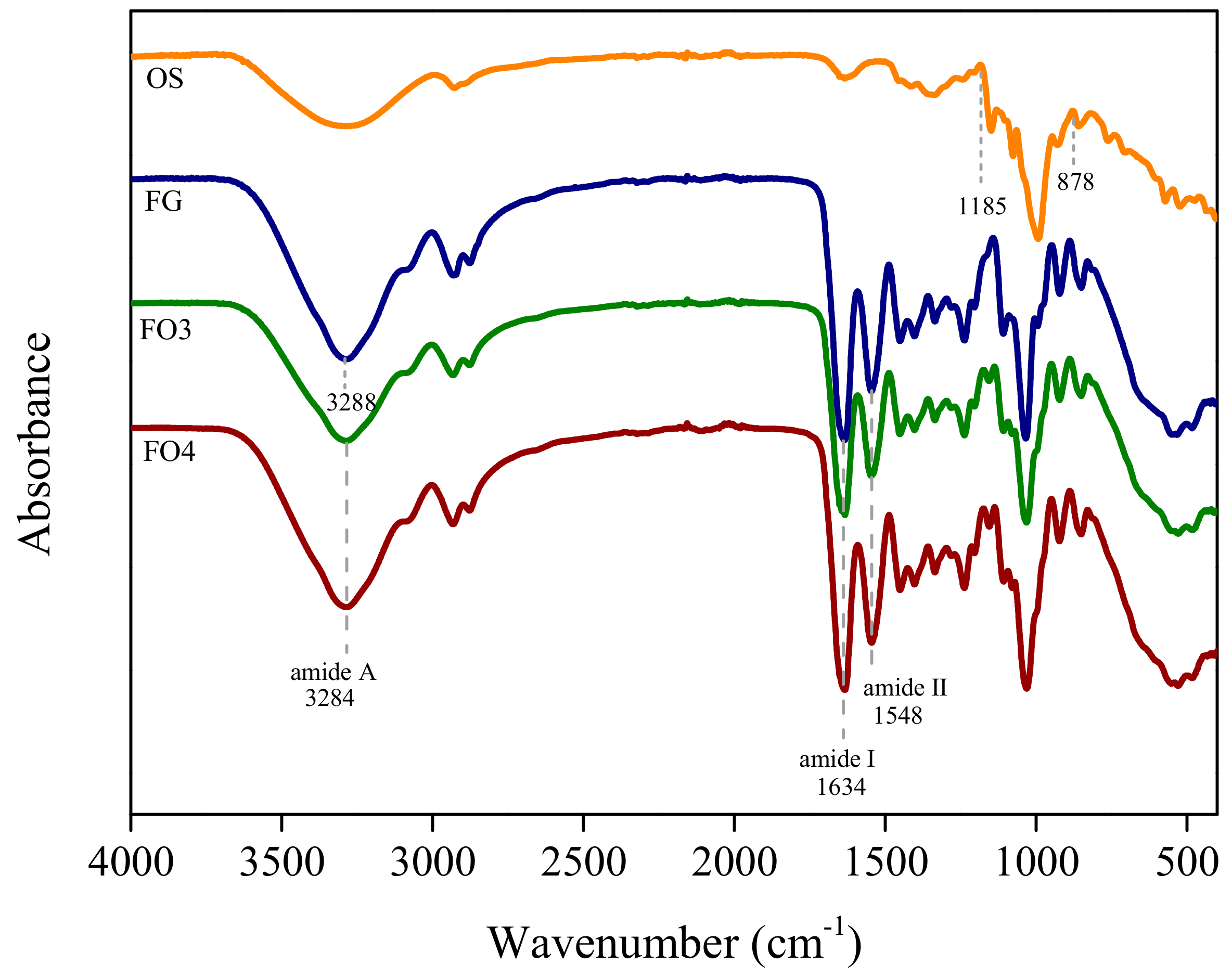
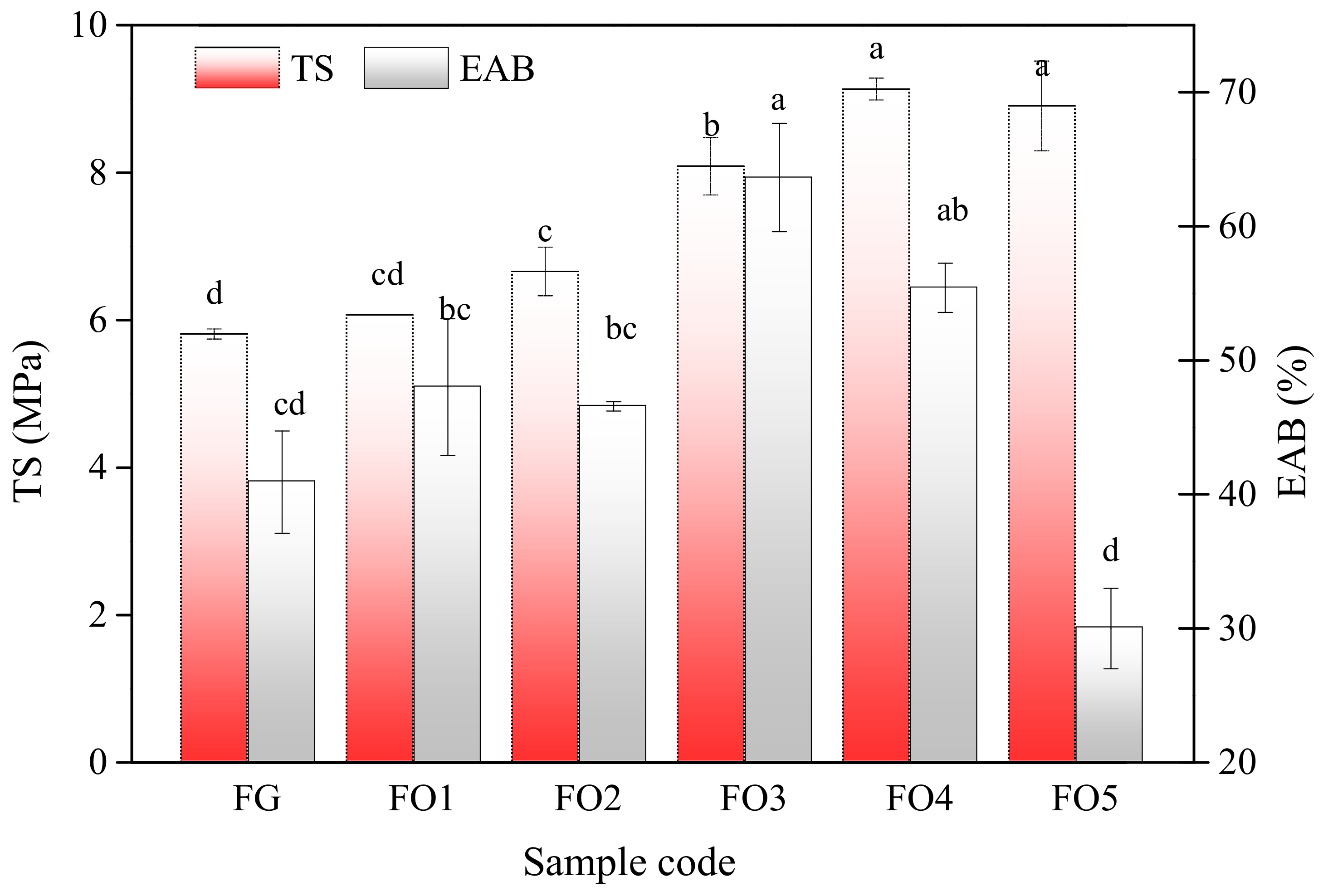
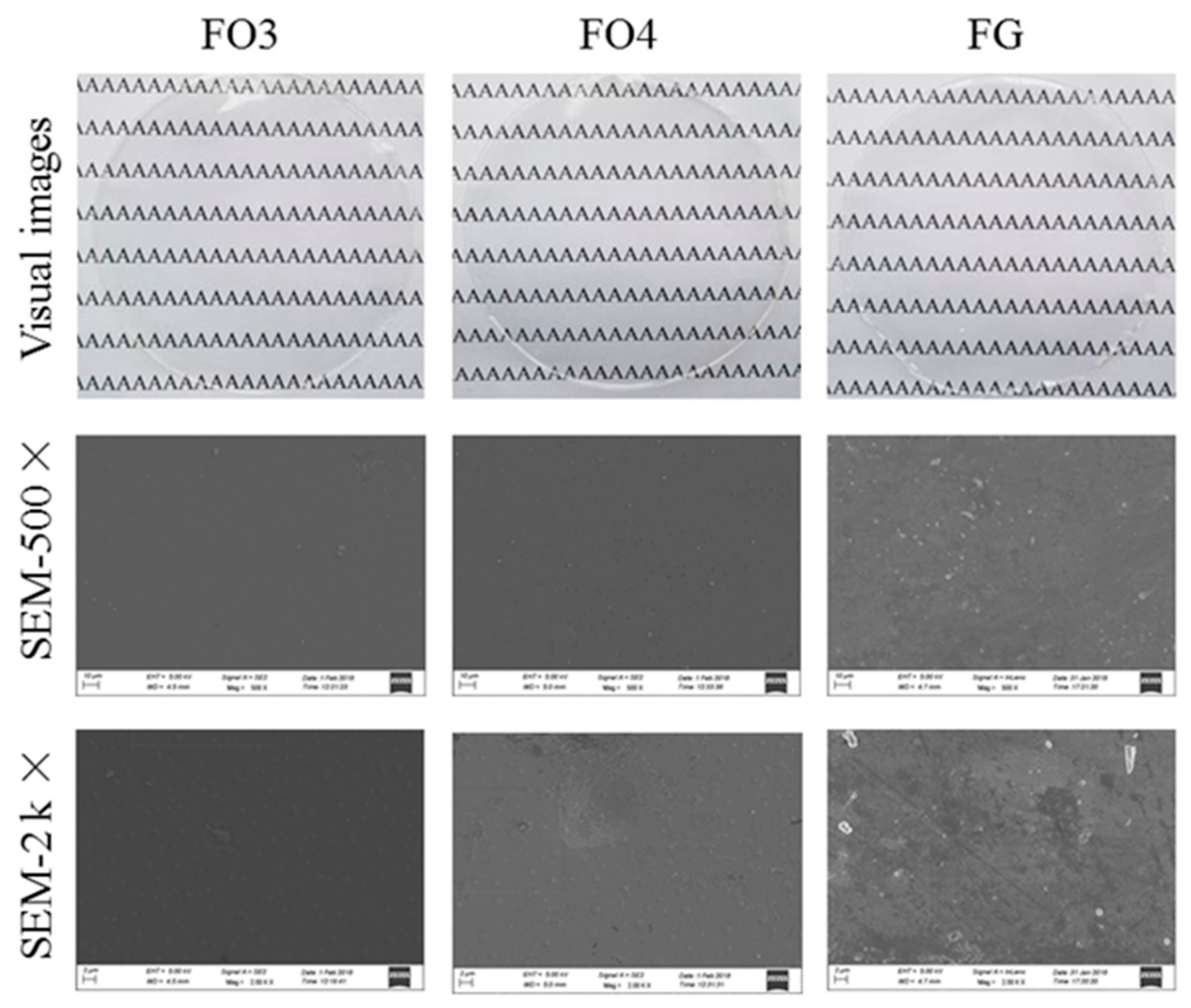
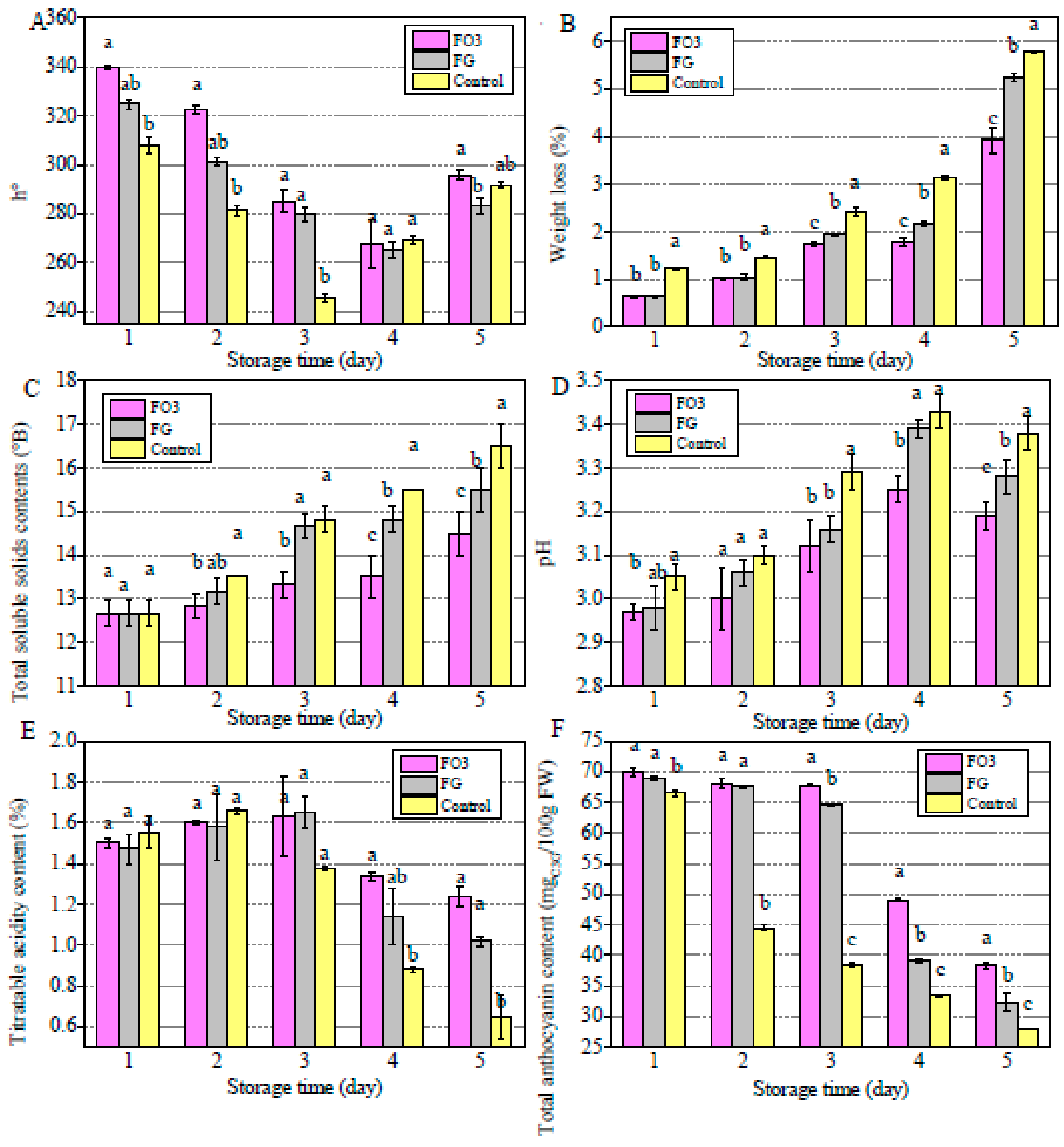
| Sample Code | L | ΔE | MC/% | WVP/gm−1d−1MPa−1 | Oil Permeability/gm−2h−1 | OP/cm3m−2 d−10.1MPa−1 |
|---|---|---|---|---|---|---|
| FG | 88.79 ± 0.26 a | 0 | 14.47 ± 0.03 c | 11.29 ± 0.99 a | 3.73 ± 0.45 a | 18.21 ± 0.01 a |
| FO1 | 87.95 ± 0.78 b | 0.91 ± 0.58 a | 14.82 ± 0.01 b | 9.91 ± 0.78 b | 3.54 ± 0.29 a | / |
| FO2 | 87.96 ± 0.18 b | 0.78 ± 0.17 a,b | 15.35 ± 0.09 a | 9.22 ± 0.31 b | 2.65 ± 0.29 b | / |
| FO3 | 88.30 ± 0.10 a,b | 0.49 ± 0.06 a,b | 14.54 ± 0.03 c | 3.64 ± 0.03 d | 0.88 ± 0.01 d | 10.98 ± 0.68 b |
| FO4 | 88.45 ± 0.26 a,b | 0.57 ± 0.15 a,b | 14.48 ± 0.12 c | 4.59 ± 0.42 d | 1.67 ± 0.17 c | 11.23 ± 1.04 b |
| FO5 | 88.58 ± 0.03 a,b | 0.41 ± 0.06 b | 13.68 ± 0.04 d | 8.03 ± 0.44 c | 2.36 ± 0.01 b | / |
| FG | FO1 | FO2 | FO3 | FO4 | FO5 | ||
|---|---|---|---|---|---|---|---|
| Light transmission (%) at different wave number (nm) | 200 | 0.12 ± 0.01 a | 0.13 ± 0.01 a | 0.13 ± 0.01 a | 0.12 ± 0.02 a | 0.11 ± 0.02 a | 0.10 ± 0.02 a |
| 280 | 44.20 ± 7.58 a | 47.57 ± 3.70 a | 47.80 ± 7.31 a | 46.10 ± 8.92 a | 43.97 ± 2.55 a | 32.47 ± 6.89 a | |
| 350 | 91.93 ± 1.10 a | 93.37 ± 0.81 a | 91.93 ± 0.72 a | 92.23 ± 0.40 a | 92.10 ± 0.78 a | 88.80 ± 1.65 b | |
| 400 | 93.20 ± 0.87 b | 94.30 ± 0.17 a | 92.93 ± 0.40 b | 93.30 ± 0.20 b | 93.43 ± 0.38 a,b | 91.37 ± 0.67 c | |
| 500 | 92.90 ± 0.66 b | 93.77 ± 0.35 a | 92.70 ± 0.17 b,c | 93.27 ± 0.25 a,b | 93.40 ± 0.35 a,b | 92.17 ± 0.76 c | |
| 600 | 93.57 ± 0.25 a | 92.70 ± 0.53 a | 92.93 ± 0.70 a | 92.93 ± 0.93 a | 93.33 ± 0.15 a | 93.57 ± 0.45 a | |
| 700 | 93.20 ± 0.95 a | 93.67 ± 0.15 a | 93.00 ± 0.60 a | 93.57 ± 0.06 a | 93.67 ± 0.35 a | 92.77 ± 0.55 a | |
| 800 | 93.23 ± 0.87 a | 93.77 ± 0.12 a | 93.07 ± 0.38 a | 93.30 ± 0.10 a | 93.57 ± 0.45 a | 92.83 ± 0.57 a | |
| T | 1.79 ± 0.02 a | 1.72 ± 0.04 a | 1.73 ± 0.05 a | 1.73 ± 0.07 a | 1.77 ± 0.45 a | 1.78 ± 0.04 a | |
© 2019 by the authors. Licensee MDPI, Basel, Switzerland. This article is an open access article distributed under the terms and conditions of the Creative Commons Attribution (CC BY) license (http://creativecommons.org/licenses/by/4.0/).
Share and Cite
Dong, Y.; Chen, H.; Qiao, P.; Liu, Z. Development and Properties of Fish Gelatin/Oxidized Starch Double Network Film Catalyzed by Thermal Treatment and Schiff’ Base Reaction. Polymers 2019, 11, 2065. https://doi.org/10.3390/polym11122065
Dong Y, Chen H, Qiao P, Liu Z. Development and Properties of Fish Gelatin/Oxidized Starch Double Network Film Catalyzed by Thermal Treatment and Schiff’ Base Reaction. Polymers. 2019; 11(12):2065. https://doi.org/10.3390/polym11122065
Chicago/Turabian StyleDong, Yuhao, Hao Chen, Peng Qiao, and Zijing Liu. 2019. "Development and Properties of Fish Gelatin/Oxidized Starch Double Network Film Catalyzed by Thermal Treatment and Schiff’ Base Reaction" Polymers 11, no. 12: 2065. https://doi.org/10.3390/polym11122065



